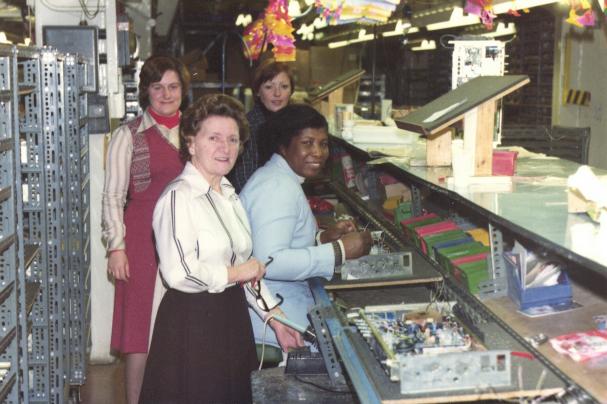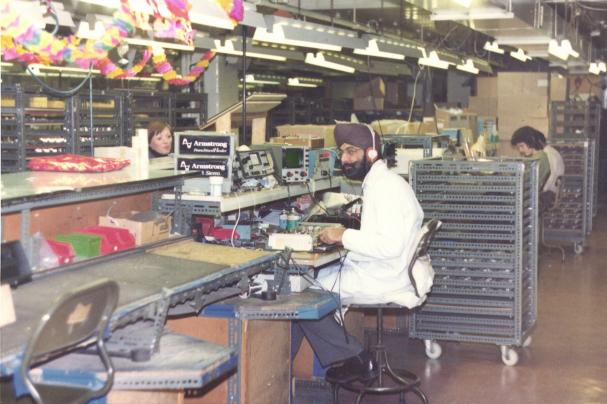Production Line in the 1970's
The precise way the line was used changed over the years, but the double-sided ‘U’-shape surrounded by stores, storage racks, and the test bays, worked very well so was retained for more than 20 years until the factory closed.
The photos on this page were all taken in the late 1970's around Christmas time - hence the decorations! The image above shows some of the production line workers. If my recollection is correct, the person in charge is Jean, and the one furthest from the camera is Carol. At that time the units in production were the 600 range. Some of these can be seen in chassis form on the track. The photos show how these were supported by end-pieces on a production board at this stage.
For most of the early decades, soldering was all done by hand. However by the late 1970's a waterfall flow solder machine was in place on the production line to automatically solder components in place. This made soldering a quicker process as well as being more controlled and repeatable. There still were occasional problems though. For example, at one time the number of boards with faulty joints started to rise. Repeated checking of the components, boards, and flow solderer failed to find any change. Then it was discovered that one of the assembly workers had taken to eating oranges whilst working. The result was that a tiny amount of orange juice was getting onto their fingers, and then onto the boards. This thin layer was sticky and acid enough to cause solder joints to fail. A change of eating/working practice solved the problem!
The above image shows one of the people responsible for adjusting and testing completed sets, and also for repairing any sets that were returned with faults. Although it is hard to read in this image, the sign in front of him reads, “Armstrong Franchised Healer” and is a modified version of the “Franchised Dealer” that was issued to dealers!
Testing sets was done mainly on the basis of individual skill and experience, although by this time the factory also used “Ferret” automatic testers. These consisted of a plate with a set of pointed metal probes. You fitted a circuit to be tested into a frame and then lowered it onto the probes. These then automatically applied test voltages to some points on the board and measured the resulting voltages in other places. If the results were as expected the circuit passed test. This speeded up testing - when it was working! Of course, when a board failed the test, a skilled tester than had to diagnose and fix the problem, or decide if the board should be scrapped.
The atmosphere in the factory was generally very positive and friendly, with a good humoured ‘family’ atmosphere. People enjoyed working there. An example of this was that at one time some workers had to be laid off as sales had fallen. A while later sales picked up, and many of the laid off people then quit other jobs they had found in order to return.
Practical jokes were also not unknown. In one case a new test and repair worker had his bench rigged with a small flexible tube that came up through a hole in the middle of his bench. When he switched on a set that had been returned for repair, the tester in the next bay blew cigarette smoke down the tube, causing the set to suddenly erupt with smoke. This prompted a frantic jump backwards by the new tester, followed by him rapidly turning off the smoking set. He then tried a few times to turn it on and measure it, each time provoking more smoke, before he realised what was really going on!

Content and pages maintained by: Jim Lesurf
using HTMLEdit and TechWriter on a StrongARM powered RISCOS machine.


